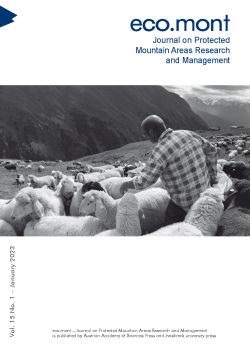Valerie Braun – Martin Coy – Günter Köck (Eds.)
eco.mont
Journal on Protected Mountain Areas Research and Management
Jiaping Xu,
Peihao Yan,
Zongyue Liu,
Huan Qin,
Aiwu Jiang
S. 38 - 45
doi:
10.1553/eco.mont-15-1s38
Verlag der Österreichischen Akademie der Wissenschaften
doi:
10.1553/eco.mont-15-1s38
Abstract:
Birdwatching has become increasingly popular over the past two decades. Because of its potential to meet both economic and conservation needs, birdwatching tourism (or avitourism) has been considered a tool for sustainable regional development. To date, very few studies have examined the impacts of avitourism in mountainous protected areas in China. We therefore conducted a case study of the Nonggang avitourism project in Southern China to explore the impacts of the activity on livelihoods and conservation. By investigating 197 local households using a structured questionnaire, we found that avitourism has improved and diversified mountain people’s livelihoods, by providing employment opportunities, and increased household incomes. Moreover, it has supported biodiversity conservation by raising mountain people’s awareness of sustainability and their willingness to conserve biodiversity. Community participation, government support and collaboration between stakeholders are important for the success of this project. We conclude that, when implemented adequately, avitourism can support sustainable mountain development.
birdwatching, avitourism, sustainable development, livelihood improvement, biodiversity conservation, mountainous protected areas
Published Online:
2022/12/27 11:15:55
Object Identifier:
0xc1aa5576 0x003debd5
Rights:https://creativecommons.org/licenses/by-nc-nd/4.0/
The journal “eco.mont” – Journal of protected mountain areas research and management – was published for the first time in June 2009.
The journal was founded as a joint initiative of the Alpine Network of Protected Areas (ALPARC), the International Scientific Committee on Research in the Alps (ISCAR), the Austrian Academy of Sciences (ÖAW) and the University of Innsbruck.
The journal aims to highlight research on and management issues in protected areas in the Alps without excluding other protected mountain areas in Europe or overseas. Its target audiences are scientists from all related disciplines, managers of protected areas and interested individuals including practitioners, visitors, teachers, etc.
The journal presents peer-reviewed articles in English by authors who research protected mountain areas and management issues within these areas. It's published twice a year as a collaboration of the Austrian Academy of Sciences Press – responsible for the e-version – and Innsbruck University Press – responsible for the print version.
Die Zeitschrift „eco.mont“ – Zeitschrift zur Forschung in Gebirgsschutzgebieten – erschien im Juni 2009 zum ersten Mal. Die Zeitschrift wurde auf Initiative des Netzwerks Alpiner Schutzgebiete (ALPARC), der Schweizer Akademie der Naturwissenschaften (ISCAR), der Österreichischen Akademie der Wissenschaften (ÖAW) und der Universität Innsbruck gegründet. Sie hat das Ziel, Themen zu behandeln, die gleichzeitig Forschung und Verwaltung in und über die Schutzgebiete der Alpen betreffen, ohne dabei andere Gebirgsschutzgebiete Europas oder anderswo auszuschließen. Diese neue Zeitschrift richtet sich an ein Publikum von Wissenschaftlern der verschiedensten Fachbereiche, an die Verwalter von Schutzgebieten und an alle sonstigen Interessierten, Praktiker, Besucher, Lehrpersonal etc. einbegriffen. Die Zeitschrift veröffentlicht begutachtete Beiträge auf Englisch von Autoren, die Fragen der Gebirgsschutzgebiete und deren Verwaltung betreffen. Sie erscheint zweimal pro Jahr, auf der Basis der gemeinsamen Anstrengungen des Verlags der Österreichischen Akademie der Wissenschaften, der für die digitale Fassung verantwortlich ist, und der Presse der Universität Innsbruck, verantwortlich für die gedruckte Fassung.



 Home
Home
 Print
Print
 References
References
 Share
Share

